Analyzing Ethical Work in Healthcare: Case Studies and Theories
VerifiedAdded on 2022/10/17
|9
|2499
|121
Essay
AI Summary
This essay delves into ethical issues within the healthcare landscape, analyzing various case studies to illuminate the complexities faced by healthcare professionals. It explores critical ethical principles such as autonomy, beneficence, non-maleficence, and justice, applying them to real-world scenarios to highlight the moral dilemmas inherent in patient care. The essay also examines the application of ethical theories, including the principle of the 'greatest good' and moral justification, to evaluate the 'rightness' or 'wrongness' of actions taken by healthcare providers, particularly in challenging situations like end-of-life decisions. Furthermore, it stresses the importance of nurses' adherence to medical standards and codes of ethics to ensure patient safety and well-being. The analysis underscores the need for ethical awareness and decision-making in healthcare, ultimately aiming to foster a deeper understanding of the moral dimensions of everyday care and the critical role of healthcare professionals in maintaining ethical practice.
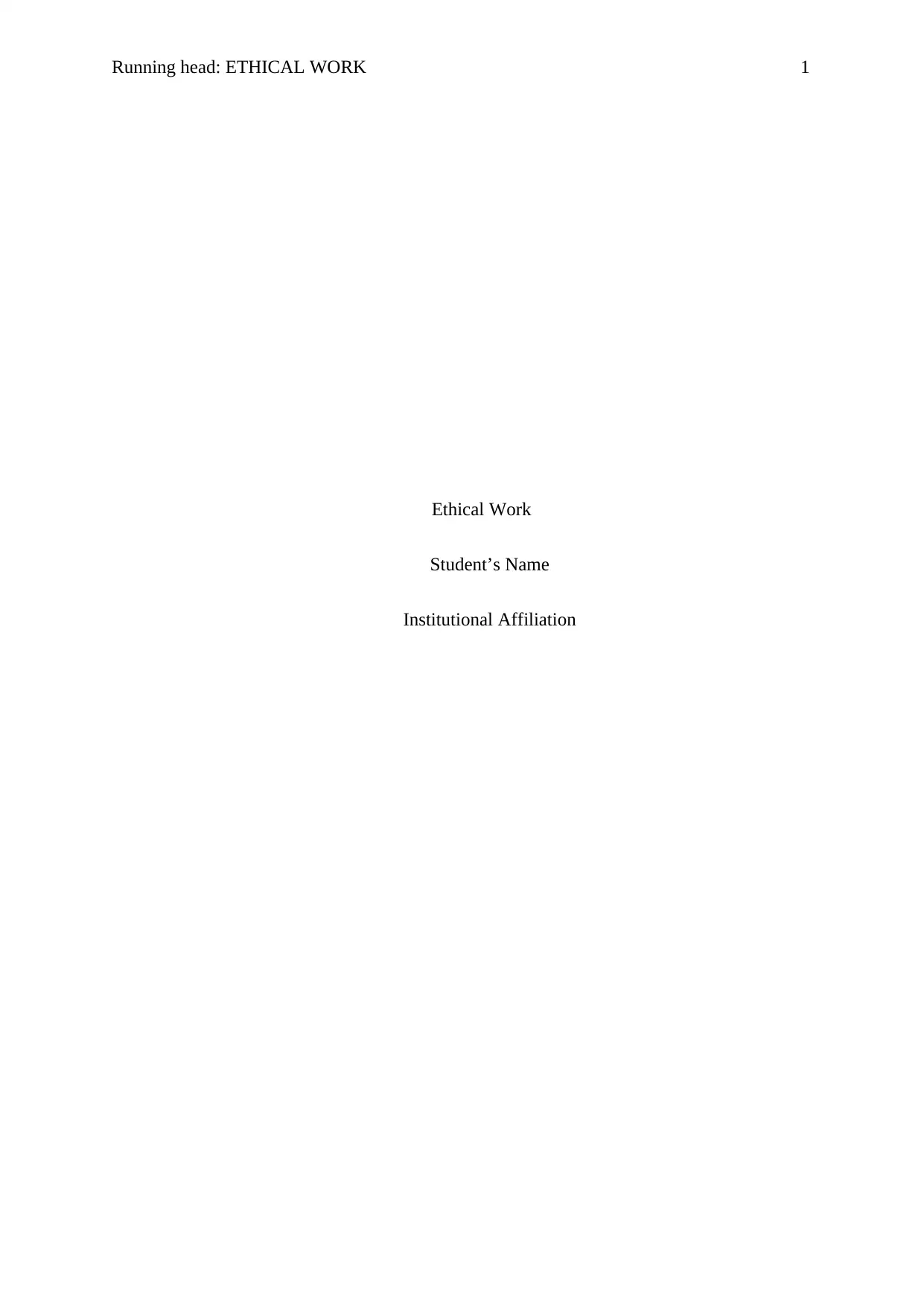
Running head: ETHICAL WORK 1
Ethical Work
Student’s Name
Institutional Affiliation
Ethical Work
Student’s Name
Institutional Affiliation
Paraphrase This Document
Need a fresh take? Get an instant paraphrase of this document with our AI Paraphraser
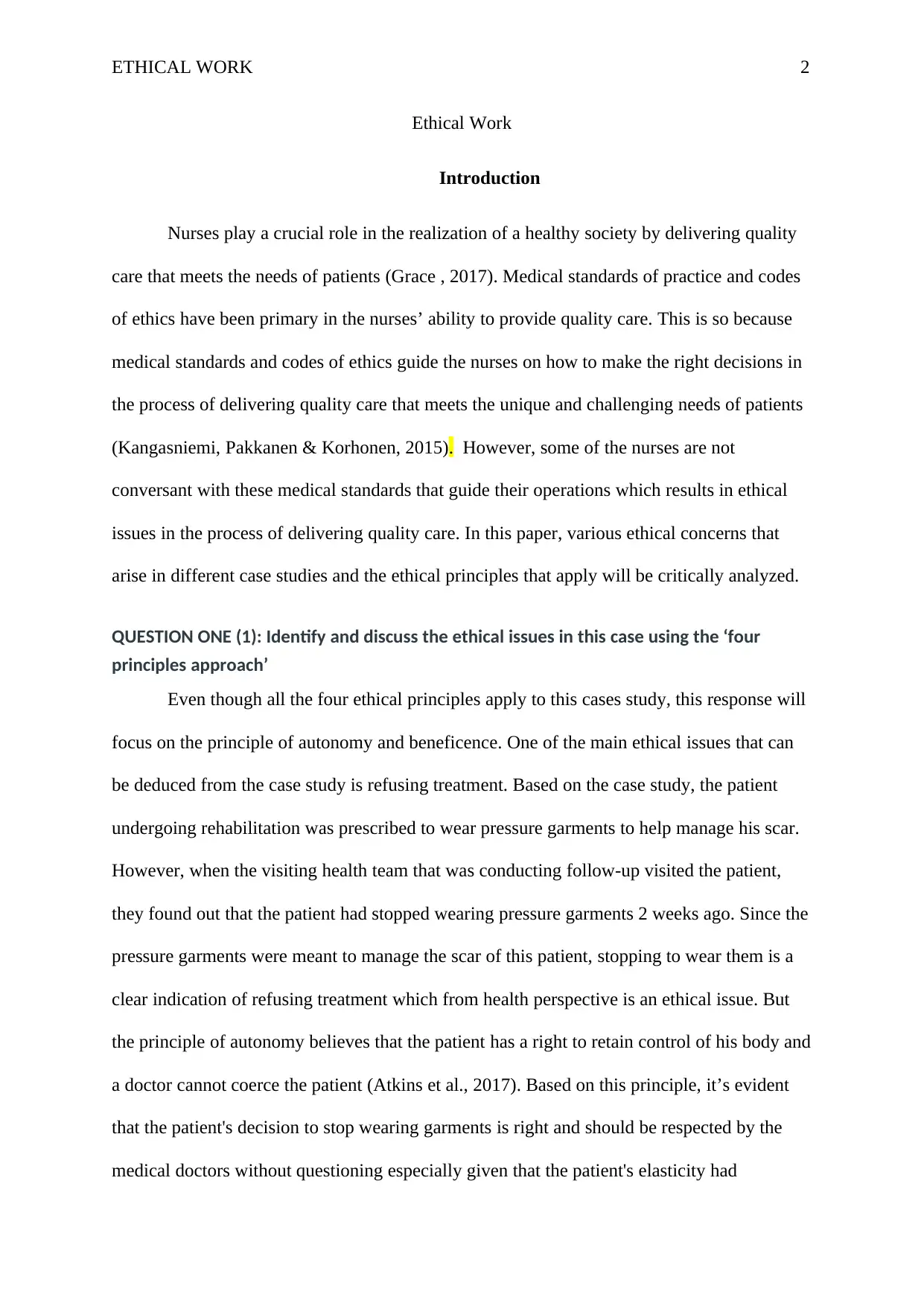
ETHICAL WORK 2
Ethical Work
Introduction
Nurses play a crucial role in the realization of a healthy society by delivering quality
care that meets the needs of patients (Grace , 2017). Medical standards of practice and codes
of ethics have been primary in the nurses’ ability to provide quality care. This is so because
medical standards and codes of ethics guide the nurses on how to make the right decisions in
the process of delivering quality care that meets the unique and challenging needs of patients
(Kangasniemi, Pakkanen & Korhonen, 2015). However, some of the nurses are not
conversant with these medical standards that guide their operations which results in ethical
issues in the process of delivering quality care. In this paper, various ethical concerns that
arise in different case studies and the ethical principles that apply will be critically analyzed.
QUESTION ONE (1): Identify and discuss the ethical issues in this case using the ‘four
principles approach’
Even though all the four ethical principles apply to this cases study, this response will
focus on the principle of autonomy and beneficence. One of the main ethical issues that can
be deduced from the case study is refusing treatment. Based on the case study, the patient
undergoing rehabilitation was prescribed to wear pressure garments to help manage his scar.
However, when the visiting health team that was conducting follow-up visited the patient,
they found out that the patient had stopped wearing pressure garments 2 weeks ago. Since the
pressure garments were meant to manage the scar of this patient, stopping to wear them is a
clear indication of refusing treatment which from health perspective is an ethical issue. But
the principle of autonomy believes that the patient has a right to retain control of his body and
a doctor cannot coerce the patient (Atkins et al., 2017). Based on this principle, it’s evident
that the patient's decision to stop wearing garments is right and should be respected by the
medical doctors without questioning especially given that the patient's elasticity had
Ethical Work
Introduction
Nurses play a crucial role in the realization of a healthy society by delivering quality
care that meets the needs of patients (Grace , 2017). Medical standards of practice and codes
of ethics have been primary in the nurses’ ability to provide quality care. This is so because
medical standards and codes of ethics guide the nurses on how to make the right decisions in
the process of delivering quality care that meets the unique and challenging needs of patients
(Kangasniemi, Pakkanen & Korhonen, 2015). However, some of the nurses are not
conversant with these medical standards that guide their operations which results in ethical
issues in the process of delivering quality care. In this paper, various ethical concerns that
arise in different case studies and the ethical principles that apply will be critically analyzed.
QUESTION ONE (1): Identify and discuss the ethical issues in this case using the ‘four
principles approach’
Even though all the four ethical principles apply to this cases study, this response will
focus on the principle of autonomy and beneficence. One of the main ethical issues that can
be deduced from the case study is refusing treatment. Based on the case study, the patient
undergoing rehabilitation was prescribed to wear pressure garments to help manage his scar.
However, when the visiting health team that was conducting follow-up visited the patient,
they found out that the patient had stopped wearing pressure garments 2 weeks ago. Since the
pressure garments were meant to manage the scar of this patient, stopping to wear them is a
clear indication of refusing treatment which from health perspective is an ethical issue. But
the principle of autonomy believes that the patient has a right to retain control of his body and
a doctor cannot coerce the patient (Atkins et al., 2017). Based on this principle, it’s evident
that the patient's decision to stop wearing garments is right and should be respected by the
medical doctors without questioning especially given that the patient's elasticity had
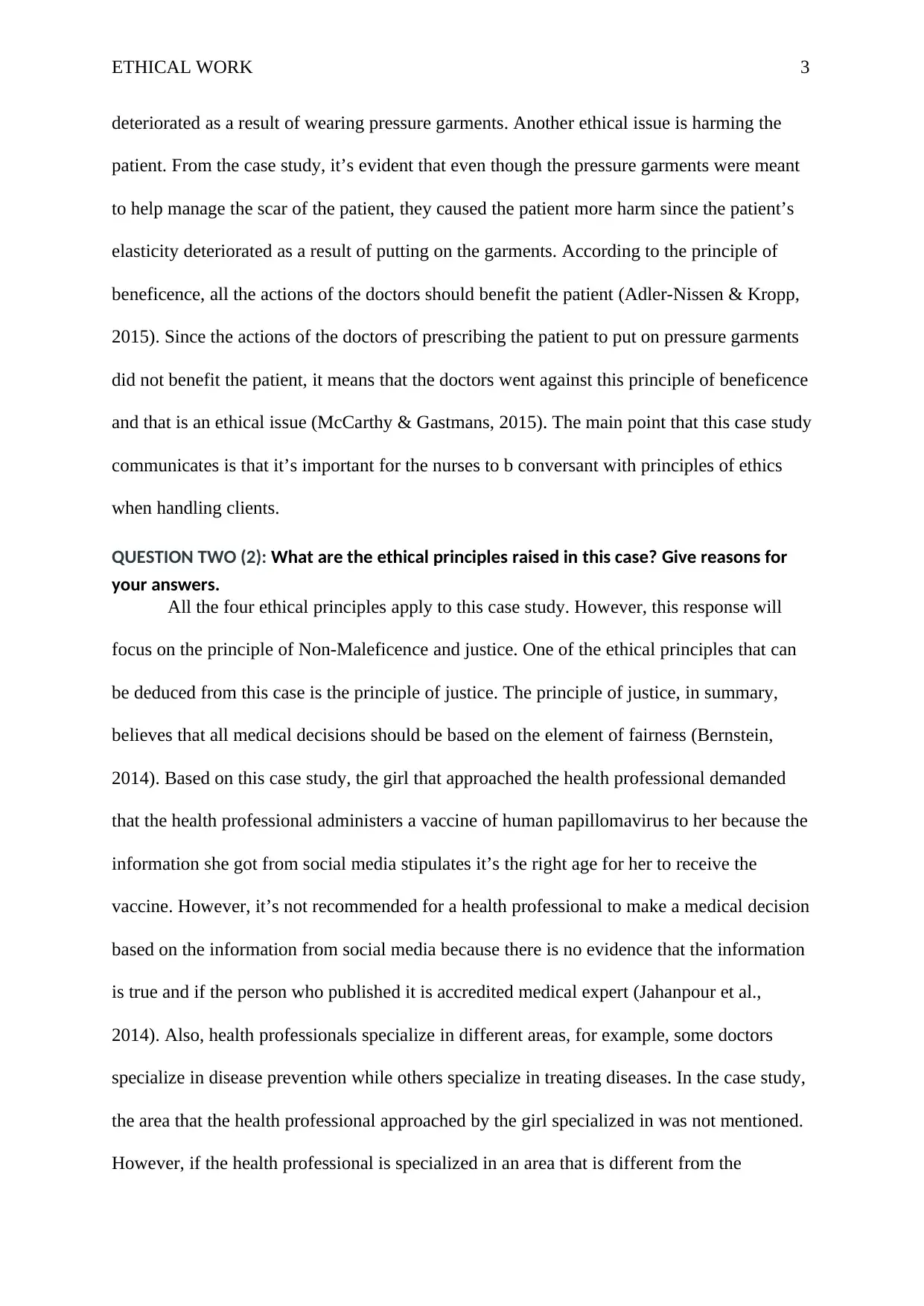
ETHICAL WORK 3
deteriorated as a result of wearing pressure garments. Another ethical issue is harming the
patient. From the case study, it’s evident that even though the pressure garments were meant
to help manage the scar of the patient, they caused the patient more harm since the patient’s
elasticity deteriorated as a result of putting on the garments. According to the principle of
beneficence, all the actions of the doctors should benefit the patient (Adler-Nissen & Kropp,
2015). Since the actions of the doctors of prescribing the patient to put on pressure garments
did not benefit the patient, it means that the doctors went against this principle of beneficence
and that is an ethical issue (McCarthy & Gastmans, 2015). The main point that this case study
communicates is that it’s important for the nurses to b conversant with principles of ethics
when handling clients.
QUESTION TWO (2): What are the ethical principles raised in this case? Give reasons for
your answers.
All the four ethical principles apply to this case study. However, this response will
focus on the principle of Non-Maleficence and justice. One of the ethical principles that can
be deduced from this case is the principle of justice. The principle of justice, in summary,
believes that all medical decisions should be based on the element of fairness (Bernstein,
2014). Based on this case study, the girl that approached the health professional demanded
that the health professional administers a vaccine of human papillomavirus to her because the
information she got from social media stipulates it’s the right age for her to receive the
vaccine. However, it’s not recommended for a health professional to make a medical decision
based on the information from social media because there is no evidence that the information
is true and if the person who published it is accredited medical expert (Jahanpour et al.,
2014). Also, health professionals specialize in different areas, for example, some doctors
specialize in disease prevention while others specialize in treating diseases. In the case study,
the area that the health professional approached by the girl specialized in was not mentioned.
However, if the health professional is specialized in an area that is different from the
deteriorated as a result of wearing pressure garments. Another ethical issue is harming the
patient. From the case study, it’s evident that even though the pressure garments were meant
to help manage the scar of the patient, they caused the patient more harm since the patient’s
elasticity deteriorated as a result of putting on the garments. According to the principle of
beneficence, all the actions of the doctors should benefit the patient (Adler-Nissen & Kropp,
2015). Since the actions of the doctors of prescribing the patient to put on pressure garments
did not benefit the patient, it means that the doctors went against this principle of beneficence
and that is an ethical issue (McCarthy & Gastmans, 2015). The main point that this case study
communicates is that it’s important for the nurses to b conversant with principles of ethics
when handling clients.
QUESTION TWO (2): What are the ethical principles raised in this case? Give reasons for
your answers.
All the four ethical principles apply to this case study. However, this response will
focus on the principle of Non-Maleficence and justice. One of the ethical principles that can
be deduced from this case is the principle of justice. The principle of justice, in summary,
believes that all medical decisions should be based on the element of fairness (Bernstein,
2014). Based on this case study, the girl that approached the health professional demanded
that the health professional administers a vaccine of human papillomavirus to her because the
information she got from social media stipulates it’s the right age for her to receive the
vaccine. However, it’s not recommended for a health professional to make a medical decision
based on the information from social media because there is no evidence that the information
is true and if the person who published it is accredited medical expert (Jahanpour et al.,
2014). Also, health professionals specialize in different areas, for example, some doctors
specialize in disease prevention while others specialize in treating diseases. In the case study,
the area that the health professional approached by the girl specialized in was not mentioned.
However, if the health professional is specialized in an area that is different from the
⊘ This is a preview!⊘
Do you want full access?
Subscribe today to unlock all pages.

Trusted by 1+ million students worldwide
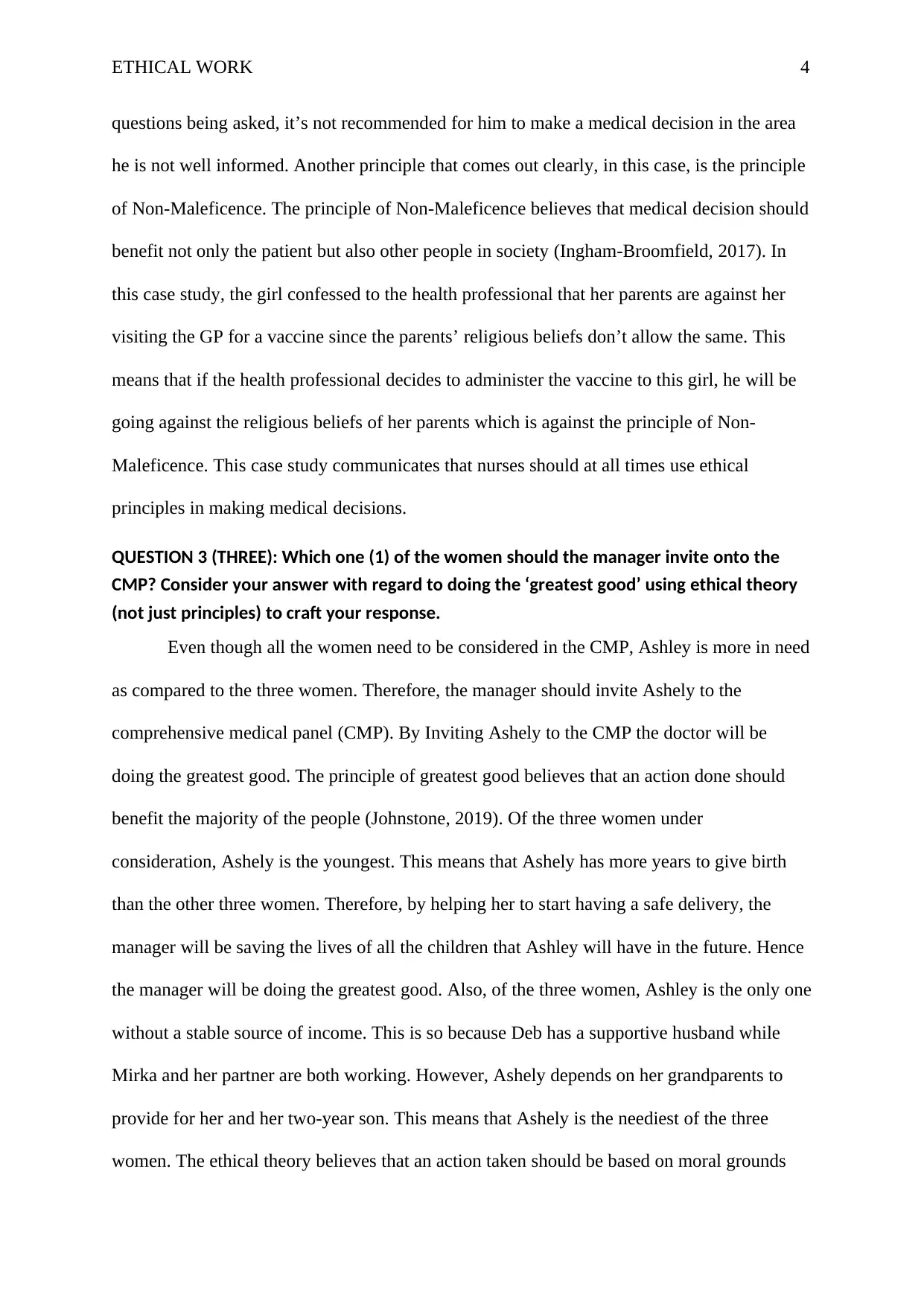
ETHICAL WORK 4
questions being asked, it’s not recommended for him to make a medical decision in the area
he is not well informed. Another principle that comes out clearly, in this case, is the principle
of Non-Maleficence. The principle of Non-Maleficence believes that medical decision should
benefit not only the patient but also other people in society (Ingham-Broomfield, 2017). In
this case study, the girl confessed to the health professional that her parents are against her
visiting the GP for a vaccine since the parents’ religious beliefs don’t allow the same. This
means that if the health professional decides to administer the vaccine to this girl, he will be
going against the religious beliefs of her parents which is against the principle of Non-
Maleficence. This case study communicates that nurses should at all times use ethical
principles in making medical decisions.
QUESTION 3 (THREE): Which one (1) of the women should the manager invite onto the
CMP? Consider your answer with regard to doing the ‘greatest good’ using ethical theory
(not just principles) to craft your response.
Even though all the women need to be considered in the CMP, Ashley is more in need
as compared to the three women. Therefore, the manager should invite Ashely to the
comprehensive medical panel (CMP). By Inviting Ashely to the CMP the doctor will be
doing the greatest good. The principle of greatest good believes that an action done should
benefit the majority of the people (Johnstone, 2019). Of the three women under
consideration, Ashely is the youngest. This means that Ashely has more years to give birth
than the other three women. Therefore, by helping her to start having a safe delivery, the
manager will be saving the lives of all the children that Ashley will have in the future. Hence
the manager will be doing the greatest good. Also, of the three women, Ashley is the only one
without a stable source of income. This is so because Deb has a supportive husband while
Mirka and her partner are both working. However, Ashely depends on her grandparents to
provide for her and her two-year son. This means that Ashely is the neediest of the three
women. The ethical theory believes that an action taken should be based on moral grounds
questions being asked, it’s not recommended for him to make a medical decision in the area
he is not well informed. Another principle that comes out clearly, in this case, is the principle
of Non-Maleficence. The principle of Non-Maleficence believes that medical decision should
benefit not only the patient but also other people in society (Ingham-Broomfield, 2017). In
this case study, the girl confessed to the health professional that her parents are against her
visiting the GP for a vaccine since the parents’ religious beliefs don’t allow the same. This
means that if the health professional decides to administer the vaccine to this girl, he will be
going against the religious beliefs of her parents which is against the principle of Non-
Maleficence. This case study communicates that nurses should at all times use ethical
principles in making medical decisions.
QUESTION 3 (THREE): Which one (1) of the women should the manager invite onto the
CMP? Consider your answer with regard to doing the ‘greatest good’ using ethical theory
(not just principles) to craft your response.
Even though all the women need to be considered in the CMP, Ashley is more in need
as compared to the three women. Therefore, the manager should invite Ashely to the
comprehensive medical panel (CMP). By Inviting Ashely to the CMP the doctor will be
doing the greatest good. The principle of greatest good believes that an action done should
benefit the majority of the people (Johnstone, 2019). Of the three women under
consideration, Ashely is the youngest. This means that Ashely has more years to give birth
than the other three women. Therefore, by helping her to start having a safe delivery, the
manager will be saving the lives of all the children that Ashley will have in the future. Hence
the manager will be doing the greatest good. Also, of the three women, Ashley is the only one
without a stable source of income. This is so because Deb has a supportive husband while
Mirka and her partner are both working. However, Ashely depends on her grandparents to
provide for her and her two-year son. This means that Ashely is the neediest of the three
women. The ethical theory believes that an action taken should be based on moral grounds
Paraphrase This Document
Need a fresh take? Get an instant paraphrase of this document with our AI Paraphraser
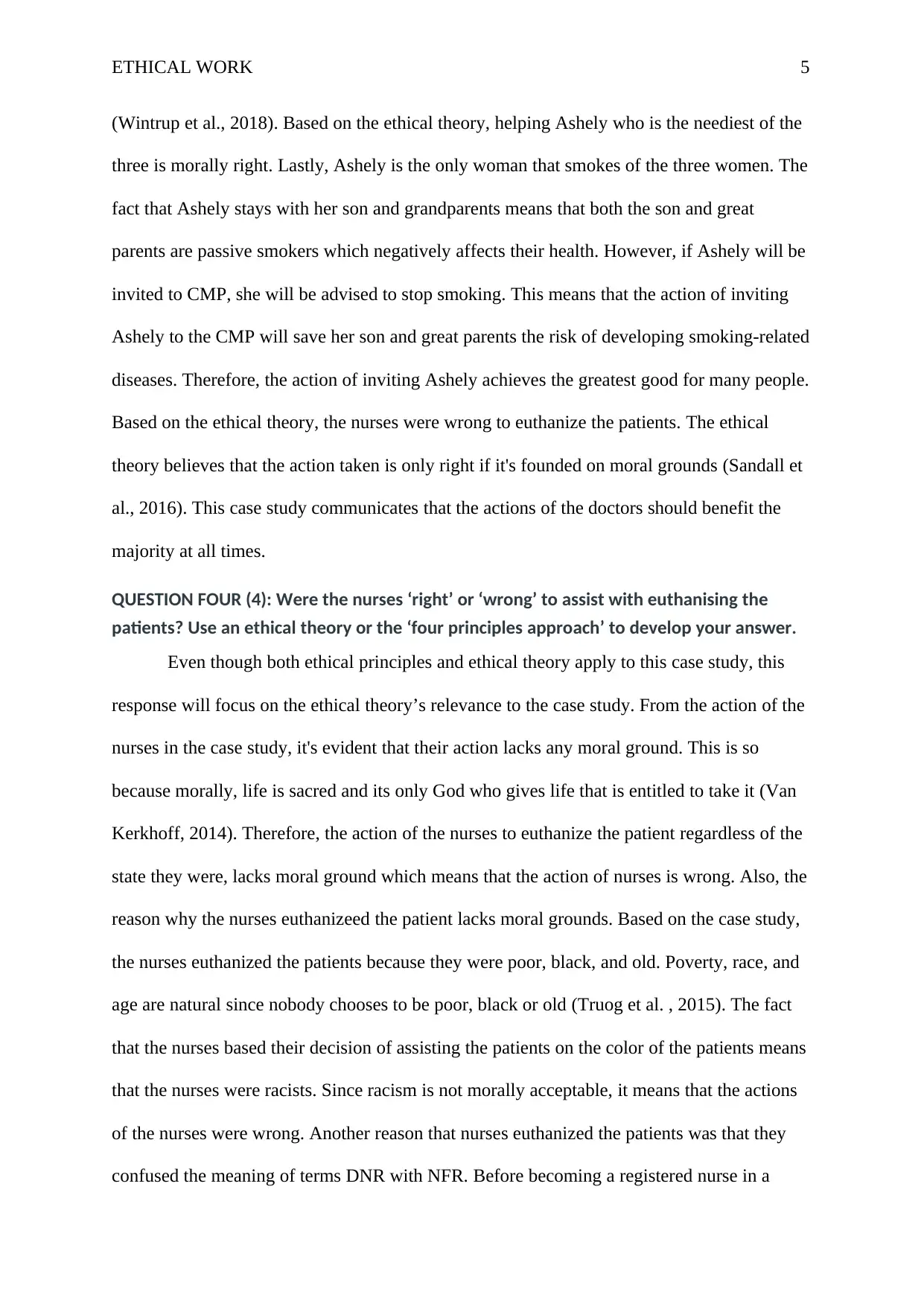
ETHICAL WORK 5
(Wintrup et al., 2018). Based on the ethical theory, helping Ashely who is the neediest of the
three is morally right. Lastly, Ashely is the only woman that smokes of the three women. The
fact that Ashely stays with her son and grandparents means that both the son and great
parents are passive smokers which negatively affects their health. However, if Ashely will be
invited to CMP, she will be advised to stop smoking. This means that the action of inviting
Ashely to the CMP will save her son and great parents the risk of developing smoking-related
diseases. Therefore, the action of inviting Ashely achieves the greatest good for many people.
Based on the ethical theory, the nurses were wrong to euthanize the patients. The ethical
theory believes that the action taken is only right if it's founded on moral grounds (Sandall et
al., 2016). This case study communicates that the actions of the doctors should benefit the
majority at all times.
QUESTION FOUR (4): Were the nurses ‘right’ or ‘wrong’ to assist with euthanising the
patients? Use an ethical theory or the ‘four principles approach’ to develop your answer.
Even though both ethical principles and ethical theory apply to this case study, this
response will focus on the ethical theory’s relevance to the case study. From the action of the
nurses in the case study, it's evident that their action lacks any moral ground. This is so
because morally, life is sacred and its only God who gives life that is entitled to take it (Van
Kerkhoff, 2014). Therefore, the action of the nurses to euthanize the patient regardless of the
state they were, lacks moral ground which means that the action of nurses is wrong. Also, the
reason why the nurses euthanizeed the patient lacks moral grounds. Based on the case study,
the nurses euthanized the patients because they were poor, black, and old. Poverty, race, and
age are natural since nobody chooses to be poor, black or old (Truog et al. , 2015). The fact
that the nurses based their decision of assisting the patients on the color of the patients means
that the nurses were racists. Since racism is not morally acceptable, it means that the actions
of the nurses were wrong. Another reason that nurses euthanized the patients was that they
confused the meaning of terms DNR with NFR. Before becoming a registered nurse in a
(Wintrup et al., 2018). Based on the ethical theory, helping Ashely who is the neediest of the
three is morally right. Lastly, Ashely is the only woman that smokes of the three women. The
fact that Ashely stays with her son and grandparents means that both the son and great
parents are passive smokers which negatively affects their health. However, if Ashely will be
invited to CMP, she will be advised to stop smoking. This means that the action of inviting
Ashely to the CMP will save her son and great parents the risk of developing smoking-related
diseases. Therefore, the action of inviting Ashely achieves the greatest good for many people.
Based on the ethical theory, the nurses were wrong to euthanize the patients. The ethical
theory believes that the action taken is only right if it's founded on moral grounds (Sandall et
al., 2016). This case study communicates that the actions of the doctors should benefit the
majority at all times.
QUESTION FOUR (4): Were the nurses ‘right’ or ‘wrong’ to assist with euthanising the
patients? Use an ethical theory or the ‘four principles approach’ to develop your answer.
Even though both ethical principles and ethical theory apply to this case study, this
response will focus on the ethical theory’s relevance to the case study. From the action of the
nurses in the case study, it's evident that their action lacks any moral ground. This is so
because morally, life is sacred and its only God who gives life that is entitled to take it (Van
Kerkhoff, 2014). Therefore, the action of the nurses to euthanize the patient regardless of the
state they were, lacks moral ground which means that the action of nurses is wrong. Also, the
reason why the nurses euthanizeed the patient lacks moral grounds. Based on the case study,
the nurses euthanized the patients because they were poor, black, and old. Poverty, race, and
age are natural since nobody chooses to be poor, black or old (Truog et al. , 2015). The fact
that the nurses based their decision of assisting the patients on the color of the patients means
that the nurses were racists. Since racism is not morally acceptable, it means that the actions
of the nurses were wrong. Another reason that nurses euthanized the patients was that they
confused the meaning of terms DNR with NFR. Before becoming a registered nurse in a
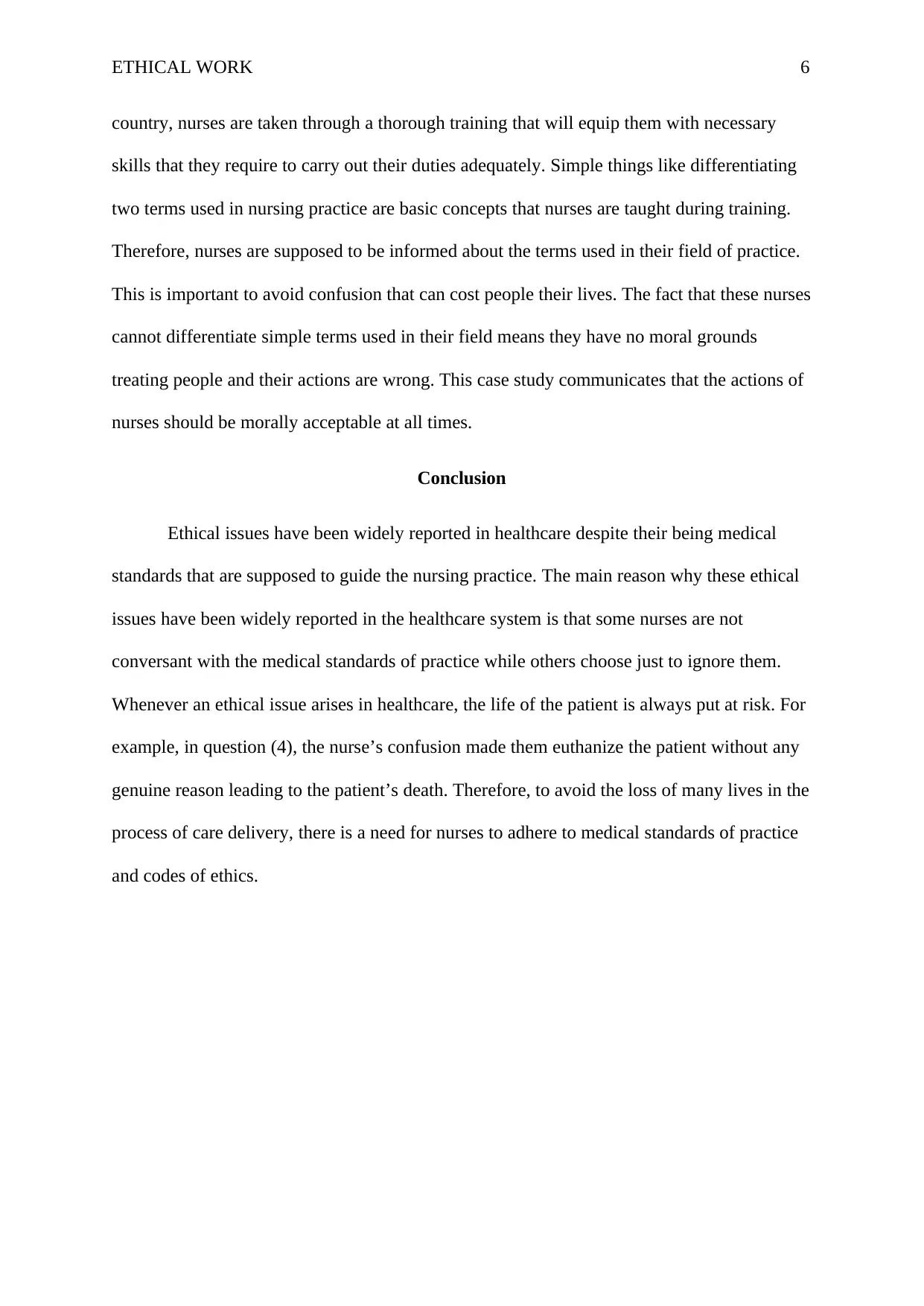
ETHICAL WORK 6
country, nurses are taken through a thorough training that will equip them with necessary
skills that they require to carry out their duties adequately. Simple things like differentiating
two terms used in nursing practice are basic concepts that nurses are taught during training.
Therefore, nurses are supposed to be informed about the terms used in their field of practice.
This is important to avoid confusion that can cost people their lives. The fact that these nurses
cannot differentiate simple terms used in their field means they have no moral grounds
treating people and their actions are wrong. This case study communicates that the actions of
nurses should be morally acceptable at all times.
Conclusion
Ethical issues have been widely reported in healthcare despite their being medical
standards that are supposed to guide the nursing practice. The main reason why these ethical
issues have been widely reported in the healthcare system is that some nurses are not
conversant with the medical standards of practice while others choose just to ignore them.
Whenever an ethical issue arises in healthcare, the life of the patient is always put at risk. For
example, in question (4), the nurse’s confusion made them euthanize the patient without any
genuine reason leading to the patient’s death. Therefore, to avoid the loss of many lives in the
process of care delivery, there is a need for nurses to adhere to medical standards of practice
and codes of ethics.
country, nurses are taken through a thorough training that will equip them with necessary
skills that they require to carry out their duties adequately. Simple things like differentiating
two terms used in nursing practice are basic concepts that nurses are taught during training.
Therefore, nurses are supposed to be informed about the terms used in their field of practice.
This is important to avoid confusion that can cost people their lives. The fact that these nurses
cannot differentiate simple terms used in their field means they have no moral grounds
treating people and their actions are wrong. This case study communicates that the actions of
nurses should be morally acceptable at all times.
Conclusion
Ethical issues have been widely reported in healthcare despite their being medical
standards that are supposed to guide the nursing practice. The main reason why these ethical
issues have been widely reported in the healthcare system is that some nurses are not
conversant with the medical standards of practice while others choose just to ignore them.
Whenever an ethical issue arises in healthcare, the life of the patient is always put at risk. For
example, in question (4), the nurse’s confusion made them euthanize the patient without any
genuine reason leading to the patient’s death. Therefore, to avoid the loss of many lives in the
process of care delivery, there is a need for nurses to adhere to medical standards of practice
and codes of ethics.
⊘ This is a preview!⊘
Do you want full access?
Subscribe today to unlock all pages.

Trusted by 1+ million students worldwide
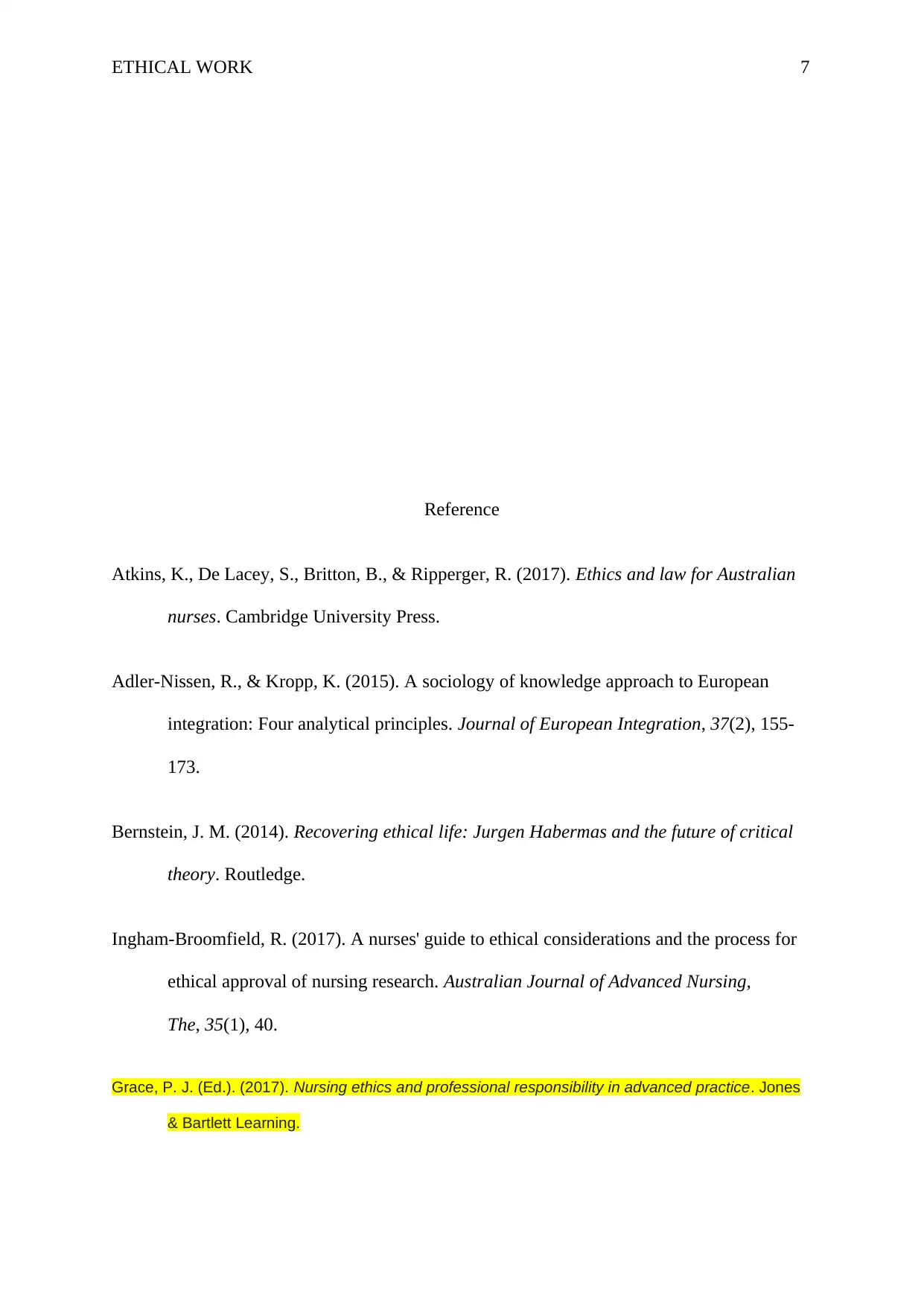
ETHICAL WORK 7
Reference
Atkins, K., De Lacey, S., Britton, B., & Ripperger, R. (2017). Ethics and law for Australian
nurses. Cambridge University Press.
Adler-Nissen, R., & Kropp, K. (2015). A sociology of knowledge approach to European
integration: Four analytical principles. Journal of European Integration, 37(2), 155-
173.
Bernstein, J. M. (2014). Recovering ethical life: Jurgen Habermas and the future of critical
theory. Routledge.
Ingham-Broomfield, R. (2017). A nurses' guide to ethical considerations and the process for
ethical approval of nursing research. Australian Journal of Advanced Nursing,
The, 35(1), 40.
Grace, P. J. (Ed.). (2017). Nursing ethics and professional responsibility in advanced practice. Jones
& Bartlett Learning.
Reference
Atkins, K., De Lacey, S., Britton, B., & Ripperger, R. (2017). Ethics and law for Australian
nurses. Cambridge University Press.
Adler-Nissen, R., & Kropp, K. (2015). A sociology of knowledge approach to European
integration: Four analytical principles. Journal of European Integration, 37(2), 155-
173.
Bernstein, J. M. (2014). Recovering ethical life: Jurgen Habermas and the future of critical
theory. Routledge.
Ingham-Broomfield, R. (2017). A nurses' guide to ethical considerations and the process for
ethical approval of nursing research. Australian Journal of Advanced Nursing,
The, 35(1), 40.
Grace, P. J. (Ed.). (2017). Nursing ethics and professional responsibility in advanced practice. Jones
& Bartlett Learning.
Paraphrase This Document
Need a fresh take? Get an instant paraphrase of this document with our AI Paraphraser
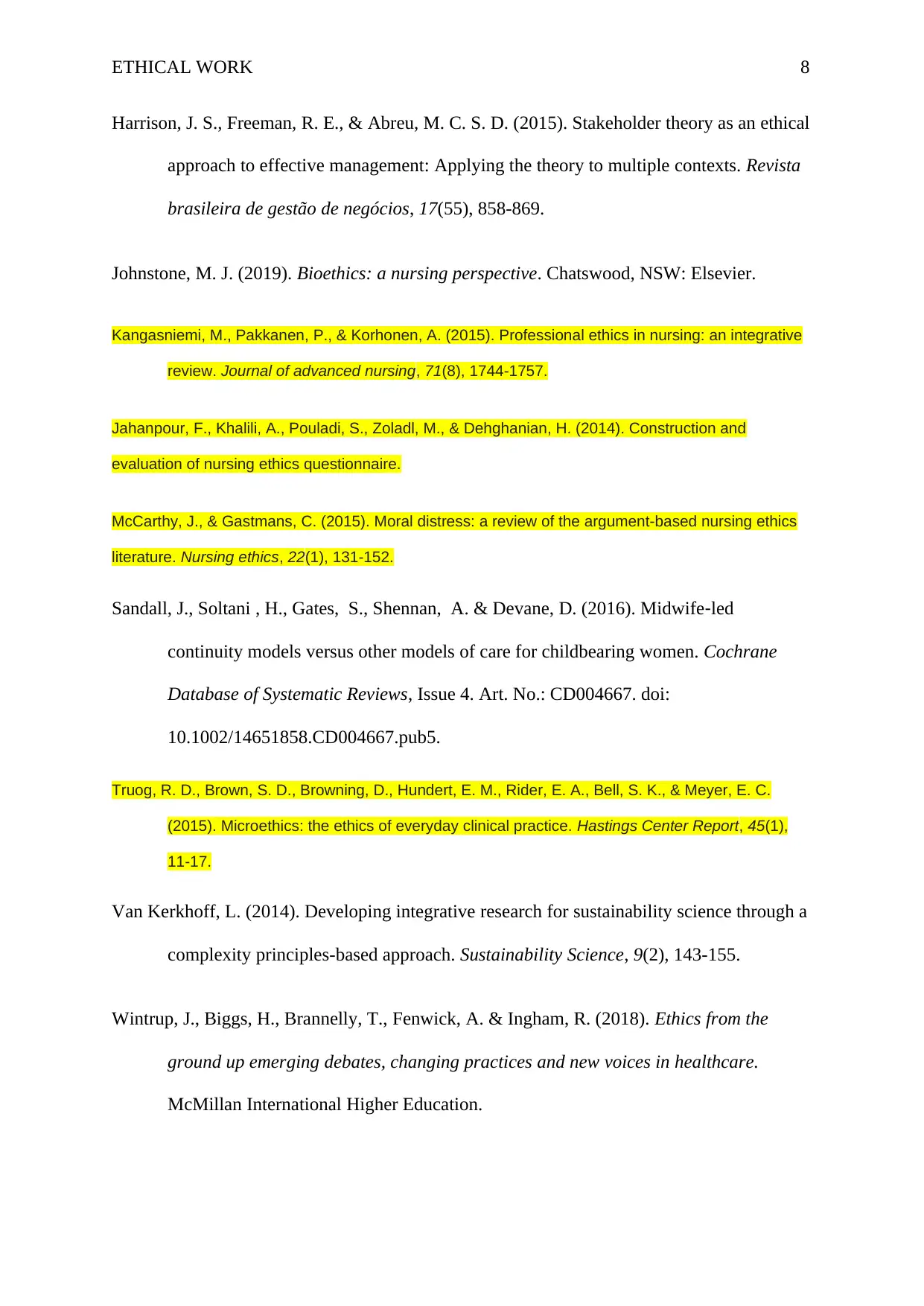
ETHICAL WORK 8
Harrison, J. S., Freeman, R. E., & Abreu, M. C. S. D. (2015). Stakeholder theory as an ethical
approach to effective management: Applying the theory to multiple contexts. Revista
brasileira de gestão de negócios, 17(55), 858-869.
Johnstone, M. J. (2019). Bioethics: a nursing perspective. Chatswood, NSW: Elsevier.
Kangasniemi, M., Pakkanen, P., & Korhonen, A. (2015). Professional ethics in nursing: an integrative
review. Journal of advanced nursing, 71(8), 1744-1757.
Jahanpour, F., Khalili, A., Pouladi, S., Zoladl, M., & Dehghanian, H. (2014). Construction and
evaluation of nursing ethics questionnaire.
McCarthy, J., & Gastmans, C. (2015). Moral distress: a review of the argument-based nursing ethics
literature. Nursing ethics, 22(1), 131-152.
Sandall, J., Soltani , H., Gates, S., Shennan, A. & Devane, D. (2016). Midwife‐led
continuity models versus other models of care for childbearing women. Cochrane
Database of Systematic Reviews, Issue 4. Art. No.: CD004667. doi:
10.1002/14651858.CD004667.pub5.
Truog, R. D., Brown, S. D., Browning, D., Hundert, E. M., Rider, E. A., Bell, S. K., & Meyer, E. C.
(2015). Microethics: the ethics of everyday clinical practice. Hastings Center Report, 45(1),
11-17.
Van Kerkhoff, L. (2014). Developing integrative research for sustainability science through a
complexity principles-based approach. Sustainability Science, 9(2), 143-155.
Wintrup, J., Biggs, H., Brannelly, T., Fenwick, A. & Ingham, R. (2018). Ethics from the
ground up emerging debates, changing practices and new voices in healthcare.
McMillan International Higher Education.
Harrison, J. S., Freeman, R. E., & Abreu, M. C. S. D. (2015). Stakeholder theory as an ethical
approach to effective management: Applying the theory to multiple contexts. Revista
brasileira de gestão de negócios, 17(55), 858-869.
Johnstone, M. J. (2019). Bioethics: a nursing perspective. Chatswood, NSW: Elsevier.
Kangasniemi, M., Pakkanen, P., & Korhonen, A. (2015). Professional ethics in nursing: an integrative
review. Journal of advanced nursing, 71(8), 1744-1757.
Jahanpour, F., Khalili, A., Pouladi, S., Zoladl, M., & Dehghanian, H. (2014). Construction and
evaluation of nursing ethics questionnaire.
McCarthy, J., & Gastmans, C. (2015). Moral distress: a review of the argument-based nursing ethics
literature. Nursing ethics, 22(1), 131-152.
Sandall, J., Soltani , H., Gates, S., Shennan, A. & Devane, D. (2016). Midwife‐led
continuity models versus other models of care for childbearing women. Cochrane
Database of Systematic Reviews, Issue 4. Art. No.: CD004667. doi:
10.1002/14651858.CD004667.pub5.
Truog, R. D., Brown, S. D., Browning, D., Hundert, E. M., Rider, E. A., Bell, S. K., & Meyer, E. C.
(2015). Microethics: the ethics of everyday clinical practice. Hastings Center Report, 45(1),
11-17.
Van Kerkhoff, L. (2014). Developing integrative research for sustainability science through a
complexity principles-based approach. Sustainability Science, 9(2), 143-155.
Wintrup, J., Biggs, H., Brannelly, T., Fenwick, A. & Ingham, R. (2018). Ethics from the
ground up emerging debates, changing practices and new voices in healthcare.
McMillan International Higher Education.
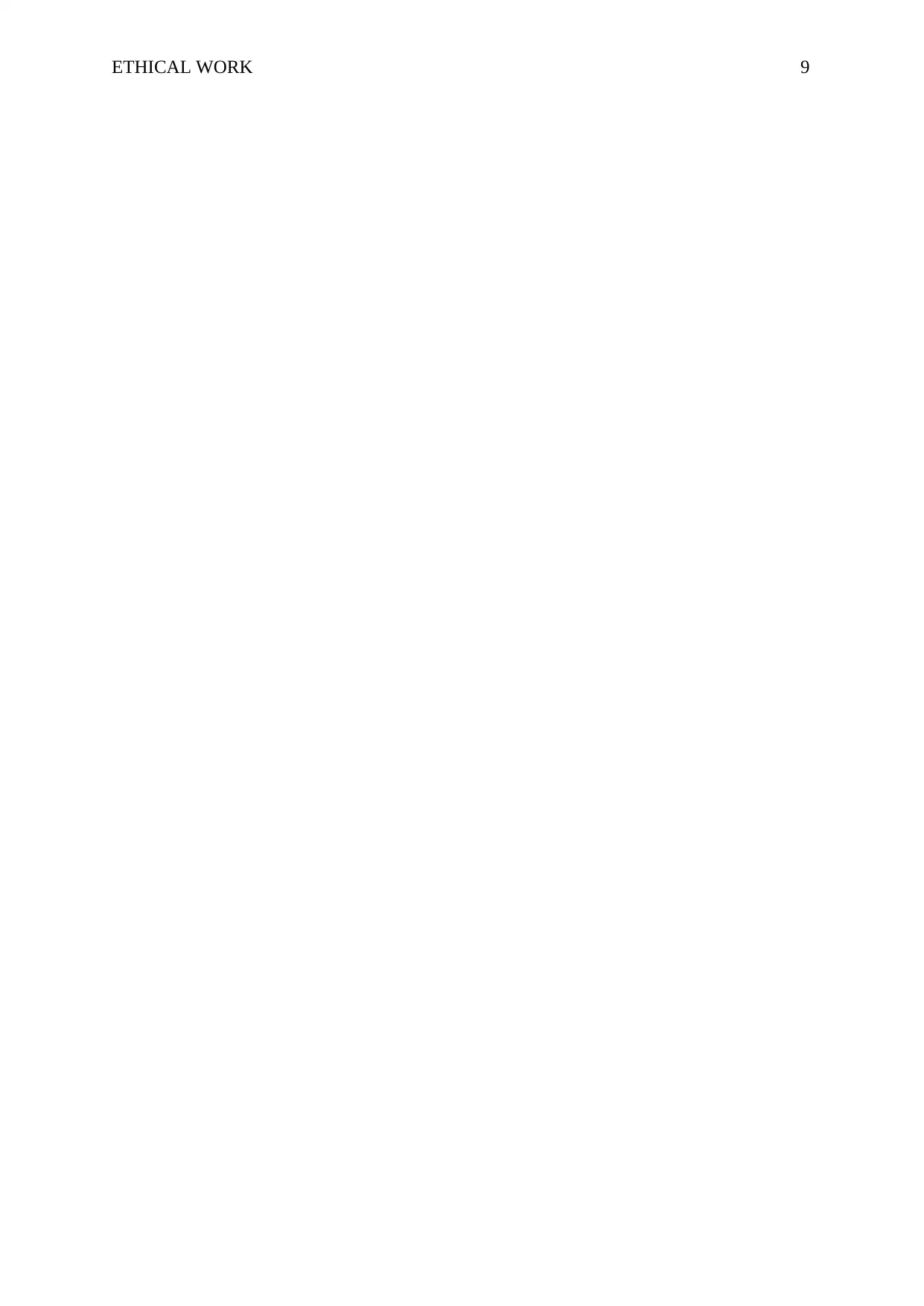
ETHICAL WORK 9
⊘ This is a preview!⊘
Do you want full access?
Subscribe today to unlock all pages.

Trusted by 1+ million students worldwide
1 out of 9
Related Documents
Your All-in-One AI-Powered Toolkit for Academic Success.
+13062052269
info@desklib.com
Available 24*7 on WhatsApp / Email
![[object Object]](/_next/static/media/star-bottom.7253800d.svg)
Unlock your academic potential
Copyright © 2020–2025 A2Z Services. All Rights Reserved. Developed and managed by ZUCOL.





